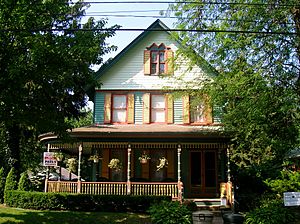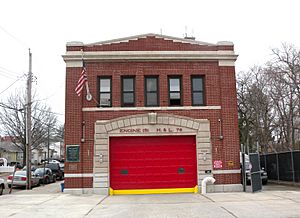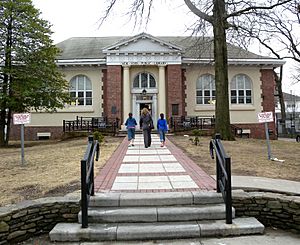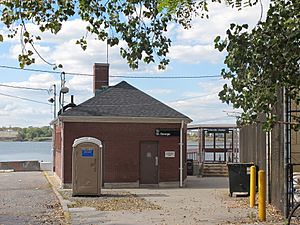Tottenville, Staten Island facts for kids
Quick facts for kids
Tottenville
|
|
|---|---|
|
Neighborhood of Staten Island
|
|
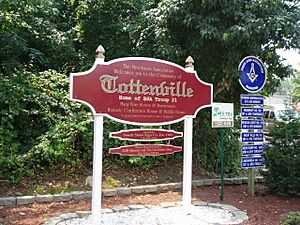
Welcome To Tottenville sign
|
|
| Country | |
| State | |
| City | |
| Borough | |
| Community District | Staten Island 3 |
| Area | |
| • Total | 6.49 km2 (2.505 sq mi) |
| Population
(2019)
|
|
| • Total | 14,780 |
| • Density | 2,278.1/km2 (5,900/sq mi) |
| Economics | |
| • Median income | $81,478 |
| Time zone | UTC−5 (Eastern) |
| ZIP Codes |
10307, 10309
|
| Area code | 718, 347, 929, and 917 |
Tottenville is a neighborhood on the South Shore of Staten Island, New York City. It is the southernmost point in both New York City and New York State. It is also the westernmost neighborhood in New York City.
Tottenville is surrounded by water on three sides. The south side faces the New York Bight. The west and north sides are next to the Arthur Kill. Nassau Place, Bethel Avenue, and Page Avenue form its eastern edge.
The area was first called Bentley Manor by Captain Christopher Billop. He was an officer in the Royal Navy. He named it after his ship. In 1869, it was renamed Tottenville. This was to honor John Totten and his important local family. Some of the Totten family members supported Billop during the American Revolutionary War.
Tottenville is part of Staten Island Community District 3. Its ZIP Code is 10307. The New York City Police Department's 123rd Precinct patrols the area. Andrew Lanza has represented Tottenville in the New York State Senate since 2007. Michael Reilly represents it in the New York State Assembly.
Contents
History of Tottenville
Early Times in Tottenville
The first people to live on Staten Island, including Tottenville, were the Lenape Indians. They were part of the Unami people. The biggest ancient burial ground, called Burial Ridge, is in Conference House Park today.
The village was first named Bentley Manor. This was by Captain Christopher Billop, one of the first settlers. He named it after his small ship, the Bentley. In 1869, the area was renamed Tottenville. This was likely to honor John Totten and his well-known family. Their names are on tombstones at Bethel Methodist Church. Some Totten family members were Loyalists during the American Revolution. They served under Captain Christopher Billopp.
For a long time, Tottenville was a key stop for travelers. People traveled between New York City and Philadelphia. Staten Island did not officially become part of New York City until 1898. Tottenville had a ferry that crossed the Arthur Kill to Perth Amboy, New Jersey. The ferry became less important after the Outerbridge Crossing opened in 1928. It stopped running in 1963.
Two special buildings stand at the north end of the neighborhood. One is the Bethel United Methodist Church. It was built in 1840 and rebuilt in 1886 after a fire. The other is an old factory. It was built in 1900 as Nassau Smelting's plant. Later, Lucent Technologies used it for recycling. It closed in 2001.
Tottenville is bordered by the Arthur Kill to the west and south. To the east is Raritan Bay. The mouth of the Arthur Kill is just south of the bay.
The Conference House was built by Christopher Billop. It is famous because peace talks to end the American Revolutionary War happened there in 1776. But the talks failed. This historic house is now the main part of a city park. The Billop family owned the land during the 1776 meeting. They were Loyalists during the war. Their land was taken away in 1784.
Tottenville has many beautiful Victorian architecture buildings. This is special for a South Shore neighborhood. Other South Shore areas were built much later. Seven buildings in Tottenville have won awards for their preservation. These include homes on Bentley Street and Brighton Street. The Tottenville Branch of the New York Public Library also won an award. The Old Church of St. Joachim and St. Anne was rebuilt after a fire. It is now a home for children.
Tottenville in the 1900s

In the past, many small factories were along the western shoreline. Most of them are now closed. Boat building also used to be big here. But this industry ended around 1900. This was because ships started to be made of steel, not wood. During World War I, shipbuilding came back for a short time. Tottenville's last shipyard closed in 1930.
Harvesting oysters from the nearby waters was important for the economy. This was true in the late 1800s and early 1900s. But it stopped in 1916. The New York City Health Department said the water was too polluted. After many years of cleaning the water, the city allowed oyster harvesting again in 2005.
Until the late 1950s, Tottenville had telephone operators. The area's phone exchange was Tottenville 8. When dial service started, it became YUkon 4.
In the 1990s, many new homes were built in Tottenville. This was in the area southeast of Hylan Boulevard. This part was almost empty before. Tottenville still has one of the lowest population densities and crime rates in New York City. Until the 2000s, most shops were on Main Street. A second shopping area grew along Page Avenue and west of Amboy Road. In 2005, the old Nassau Smelting plant was redeveloped. Cleanup of the site started in October 2006. The site had chemicals from recycling copper and other metals. Mill Creek, which runs through the site, was also cleaned.
Tottenville Beach was mostly empty until the 1990s. It is now only for homes. It is next to Conference House Park. The beach is most popular for fishing. It is not as popular for swimming or sunbathing. In the early 1900s, there were several hotels along the shore. The Coral Bay Cafe restaurant was there, but Hurricane Sandy destroyed it.
Tottenville in the 2000s
Many large, old homes built in the 1800s are still standing in Tottenville. But in the early 2000s, land developers started buying these properties. They wanted to tear down the old houses and build townhouses. One house at 7484 Amboy Road, built around 1870, became a big local issue in 2005. A builder bought it and wanted to tear it down. He planned to build five townhouses. The community was very upset.
The public outcry caused New York City mayor Michael Bloomberg to act. He had the home declared a landmark. This stopped it from being torn down. Bloomberg announced his decision on March 22. The New York City Landmarks Preservation Commission made it official on April 12. After years of being empty and needing repairs, the home was fixed up in 2017.
In March 2008, more than 20 blocks in the northern part of Tottenville became one-way streets. This was done to help traffic flow better on the older, narrower roads.
In 2016, a group bought 30 acres of the Nassau Smelting property. They wanted to change the land use from manufacturing to residential. This would allow them to build homes. But the community was against this. The soil was still contaminated from the metal recycling. The future of this property is still undecided.
People of Tottenville
Tottenville is part of a larger area called Charleston-Richmond Valley-Tottenville. In 2010, this area had 23,313 people. Most residents are white (84.4%). About 8.8% are Hispanic or Latino.
Most people in Tottenville are youth and middle-aged adults. About 21% are under 18. About 26% are between 25 and 44. And 29% are between 45 and 64.
In 2017, the average household income in Tottenville was $81,478. About 11% of residents live in poverty. This is lower than the average for Staten Island and New York City. Tottenville is considered a high-income area.
The neighborhood has many upper-middle-class families. It has the highest number of Roman Catholics on Staten Island (94%). In the mid-2000s, the first Mexican immigrants moved here. There are also more Coptic Orthodox Christians from Egypt. Tottenville's white population is 60% Italian.
Fun and Entertainment
The Stadium Theatre was a movie theater in Tottenville. It had 1,037 seats and was open from 1927 to 1957. In 1969, it reopened as the New Stadium Theatre. It hosted rock music bands like The Brooklyn Bridge. By the 1970s, it became a roller rink. It is now closed, and there are no plans to reopen it.
Fire Safety
The New York City Fire Department (FDNY) serves Tottenville. Engine Co. 151/Ladder Co. 76 is located at 7219 Amboy Road.
Post Office and ZIP Codes
Tottenville uses the ZIP Code 10307. The United States Postal Service has a post office in Tottenville. It is located at 228 Main Street.
Education in Tottenville
Tottenville has a similar number of college-educated residents as the rest of New York City. About 41% of adults aged 25 and older have a college degree or higher. About 8% have less than a high school education. And 51% are high school graduates or have some college.
The number of elementary school students who miss many school days is lower in Tottenville. Only 12% of elementary students missed twenty or more days. This is less than the city average of 20%. Also, 89% of high school students in Tottenville graduate on time. This is higher than the city average of 75%.
Schools in Tottenville
Tottenville High School was originally in the neighborhood. But a new campus opened in 1971 in Huguenot. Totten Intermediate School 34 (I.S. 34) now uses the old high school building. One of the oldest school buildings is P.S.1 (the Tottenville School). It dates back to 1878. It is still used today, along with a newer building built in 1929. In 2000, a new elementary school, P.S.6 (the Corporal Allan F. Kivlehan School), opened. It serves eastern Tottenville and nearby areas. Tottenville's local Catholic school was Our Lady Help of Christians School. It was run by Our Lady Help of Christians Parish. The school opened in 1904. It closed at the end of the 2018–2019 school year.
Tottenville Library
The New York Public Library (NYPL)'s Tottenville branch is at 7430 Amboy Road. This one-story Carnegie library building was designed by Carrère and Hastings. It opened in 1904. It is a New York City designated landmark.
Getting Around Tottenville
The Tottenville station is the end of the Staten Island Railway. The railway was extended to Tottenville on June 2, 1860. Today, Tottenville has the two southernmost stations on the line. These are Tottenville station and Arthur Kill station. Tottenville station is the southernmost railway station in New York state. Before Arthur Kill station opened in 2017, there were two other stations: Atlantic and Nassau. These closed when Arthur Kill station opened. The 14-mile trip to the St. George Terminal takes 42 minutes.
Tottenville has local buses like the S59, S78. Express buses to Manhattan are the SIM2, SIM25, SIM26.
No highways go through Tottenville. But NY Route 440 and Korean War Veterans Parkway are nearby.
Famous People from Tottenville
- Patti Hansen: A model and actress married to Rolling Stones guitarist Keith Richards. She was born and grew up in Tottenville.
- George H. Pepper: An archeologist from the early 1900s. He worked on digs from Burial Ridge to Chaco Canyon in New Mexico. He was born here.
- Paul Zindel: A playwright and young adult author from the 1900s. He was born here.
- Andy Milligan: An American playwright, screenwriter, actor, and filmmaker. He ran a hotel and lived here in the mid-1970s.
- Jason Marquis: An MLB player who played for Tottenville High School.




